The Huawei Ascend Mate 7 Review
by Andrei Frumusanu on December 2, 2014 8:00 AM EST- Posted in
- Smartphones
- Huawei
- Mobile
- Ascend Mate 7
- HiSilicon
CPU Performance
Let's a better look at the Kirin 925's performance in terms CPU power. Again, this SoC is merely a slightly higher clocked Hi3630 as we've already benchmarked on the Huawei Honor 6. The basic hardware remains the same - a 1.8GHz quad A15 cluster with 2MB of L2 and a 1.3GHz quad A7 cluster with 512kB of L2 cache. The setup is running on an HMP (Heterogeneous Multi-Processing) hardware implementation running on a Linaro GTS (Global Task Scheduling) software stack on the Linux kernel. Memory is provided by 2GB of LPDDR3-1600 memory in this unit, with a higher 3GB variant available.
First, we take a look at our browser suites, testing general Javascript performance inside Chrome.
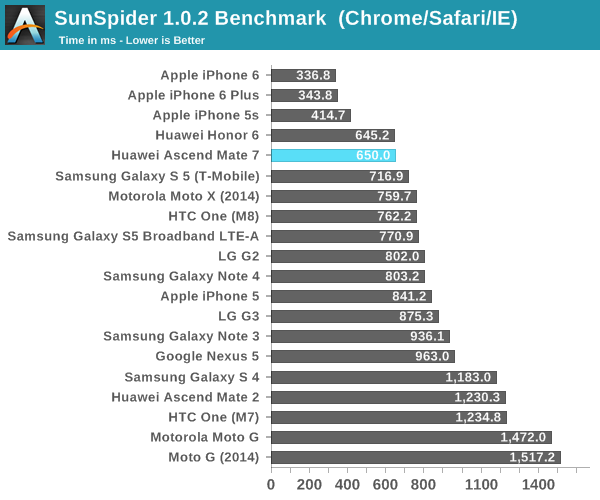
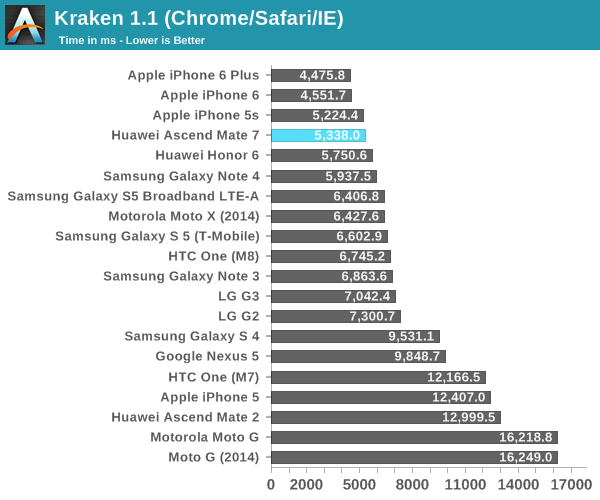
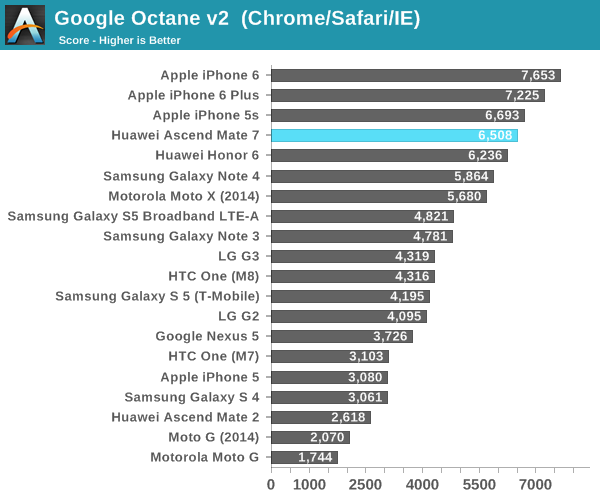
As expected, the Mate 7 doesn't differ too much from the Honor 6. The slight 100MHz boost on the A15 cluster brings it a few slight percentages above the Kirin 920. Again we see the big.LITTLE configuration and the A15 in general being extremely well-performing in these tests, being at the forefront of Android performance and only being beaten by Apple's own chip architectures. It's safe to say that the CPU has no issues at all in delivering an excellent and fast web-browsing experience.
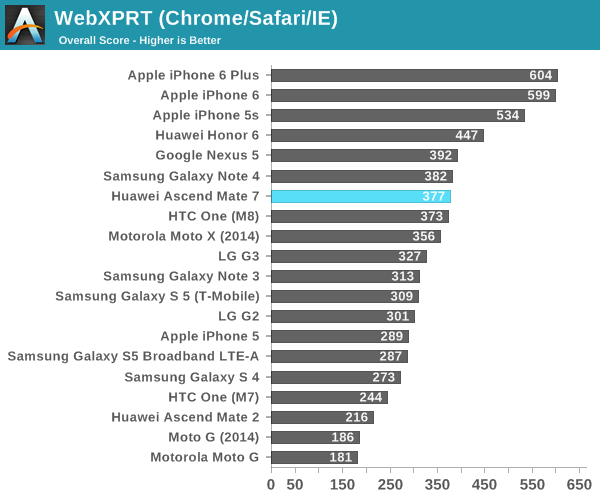
WebXPRT has behaved weirdly on the Mate 7, it consistently scores less than the Honor 6 even although they employ the same chip. I'm not too sure as why this happened. My assumption is that there might be some software regressions in Huawei's OS libraries, but it's weird to see WebXPRT being the sole test unit to suffer from this effect. Because the CPU is running at a higher clock and voltage, we might be seeing some problem with throttling as WebXPRT tends to run much longer than the previous benchmarks.
Let's continue on with BaseMark OS II, a benchmark which tries to measure several aspects of a system.
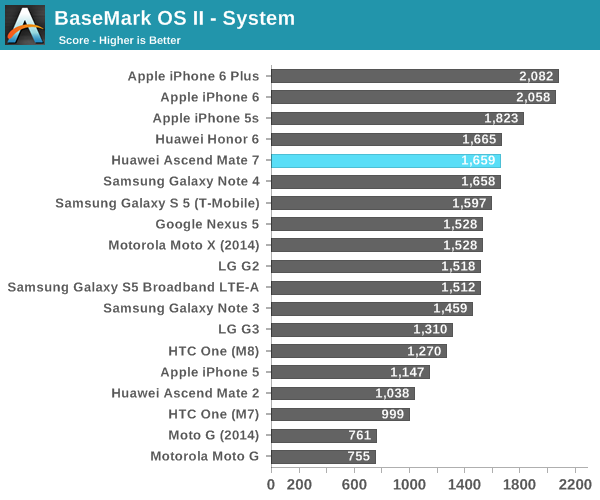
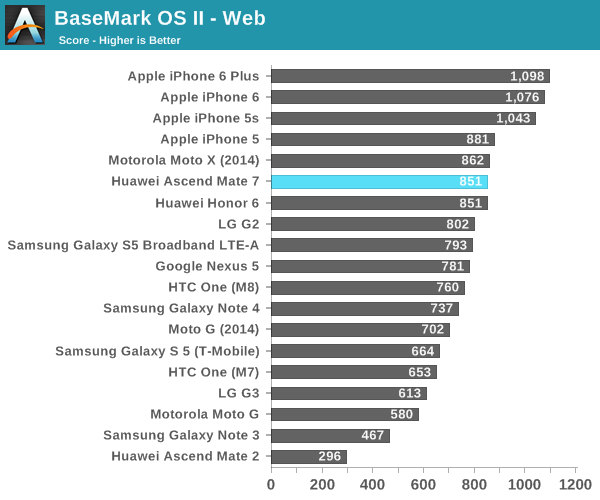
The System and Web tests in BaseMark are mainly CPU limited. We see a similar ordering as in the Javascript benchmarks, with the Kirin leading the Android devices behind Apple's iPhones.
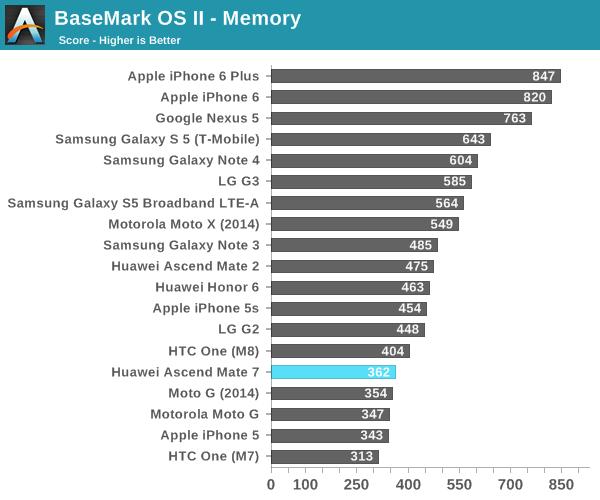
The memory benchmark is performing very weakly here. As a reminder, BaseMark is also testing the NAND performance in the memory sub-test, and not the main memory.
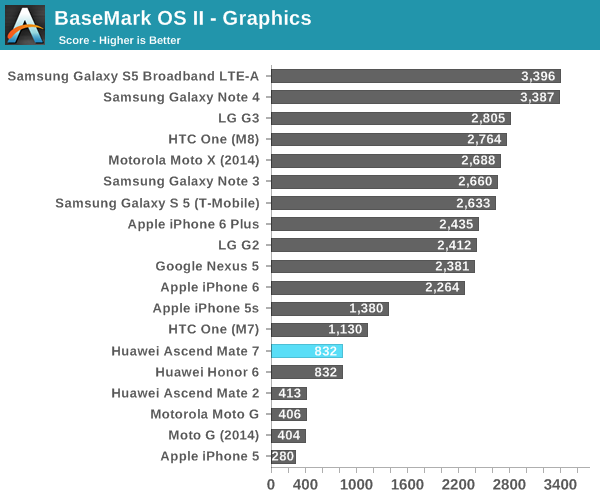
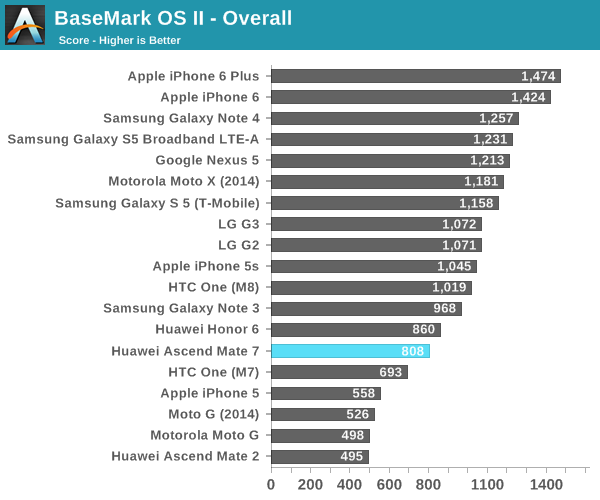
Like on the Honor 6, the Mali is having big issues with BaseMark OS II's Graphics benchmark and ends up below even Qualcomm's last generation's GPU. This, in conjunction with the lower memory score brings the overall BaseMark score further down.
Again the Mate 7 performed worse than the Honor 6. We're starting to see a trend here where longer lasting performance tests perform worse on the Mate 7, again I suspect a throttling issue here. Before we dwell more deeply into that, let's revise the performance of the Mali T628MP4 again.










72 Comments
View All Comments
Laststop311 - Tuesday, December 2, 2014 - link
Wish we could have some american phones with battery life like this.arsjum - Tuesday, December 2, 2014 - link
Andrei,Any chance you'll be reviewing Galaxy Note 4 exynos version?
Andrei Frumusanu - Tuesday, December 2, 2014 - link
I've been working on the article for 2 weeks, it's coming.DanD85 - Tuesday, December 2, 2014 - link
Thanks for reviewing this Huawei phone, anandtech. These days, Chinese manufacturers have much more interesting devices compare to the old players. Anandtech has been my favorite tech review site for more than 10 years and you guy offer the most in depth review on the whole interweb. Keep up the great work!Sicariase - Wednesday, December 3, 2014 - link
Seriously Andrei, thanks for this review. I've been tossing up between the note 4 and this for a couple of weeks, and just decided to get the huawei (didn't think the differences were massive from other reviews) when this review came out. You've potentially saved me from a world of disappointment.Bondurant - Wednesday, December 3, 2014 - link
As with other reviews on this site, the problem in this review is that there is no corresponding reference to real life usage. Just lots of numbers but for example why not a real life gaming comparison between Mate 7 and Note 4 ? NAND performs horrible in benchmarks but if in real life there is barely any noticeable change, than does the benchmark score even matter ? How about comparing the photos with other 13MP IMX214 phones ? Also frustrating i found is there is no explanation as to what exactly is the cause of poor battery performance of Mate 7, is it the fault of GPU or their modem or that it does not use a amoled screen like Note 4 ? Is it a fixable issue with rom updates ?Ofcourse ideally Huawei could have simply thrown in some Qualcomm and so on like Samsung does, but it prevents the development of Hauwei's own innovations and implementations. HiSilicon from its last year K3V2 to this years Kirin 925, there is huge improvement and they are already releasing their 64bit chip kirin 930 this December and a Kirin 950 in June.
Andrei Frumusanu - Wednesday, December 3, 2014 - link
Basically the cause of bad battery life is that power consumption of the Kirin SoC is too high - I've explained this in the review of the Honor 6 where I took an in-depth look into the chip.Bondurant - Wednesday, December 3, 2014 - link
But a comparison between Honor 6 and Samsung S5 (both the Qualcomm and Exynos version) battery life don't show Kirin SOC having such suspected high battery drain problem, although yes you did mention ways battery life could have been improved but nothing to say of a huge problem.The case with Mate 7 on the other hand with 1000mAh more battery than Honor 6 does seem weird that the battery life improvements are only marginal.
Andrei Frumusanu - Monday, December 8, 2014 - link
I did point out that the Honor 6 is less efficient than competing devices.johnny_boy - Thursday, December 4, 2014 - link
Are you serious? I own an Honor 6 and I'm getting two days of battery life under normal usage (YouTube, Gmail, Gcal, pdf reading, etc.) Under light usage I can get 2.5-3 days. This is with wifi on and auto half brightness, which I find comfortable. I'm even using Firefox for Android with adblock for browsing which is likely worse on the battery than Chrome. Some REALISTIC battery life numbers would be pretty useful--like how long were you getting under what you deem light/normal/heavy usage?